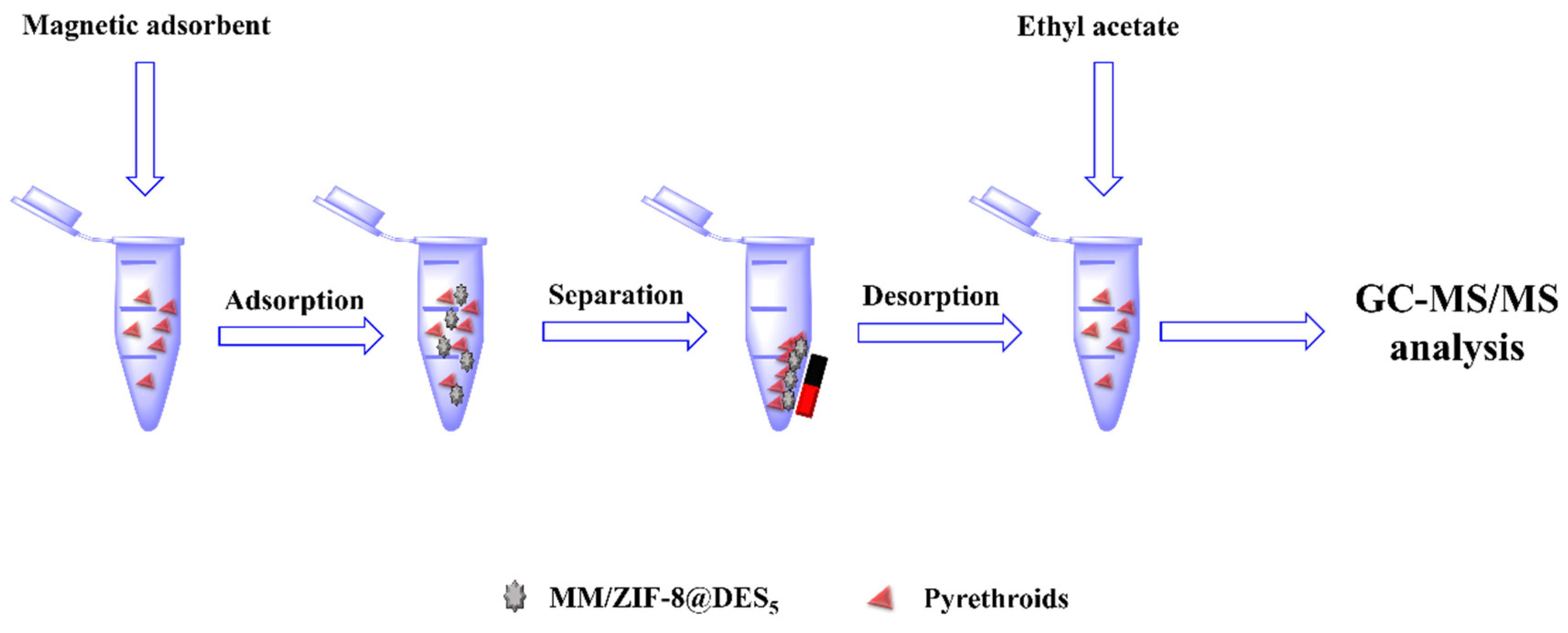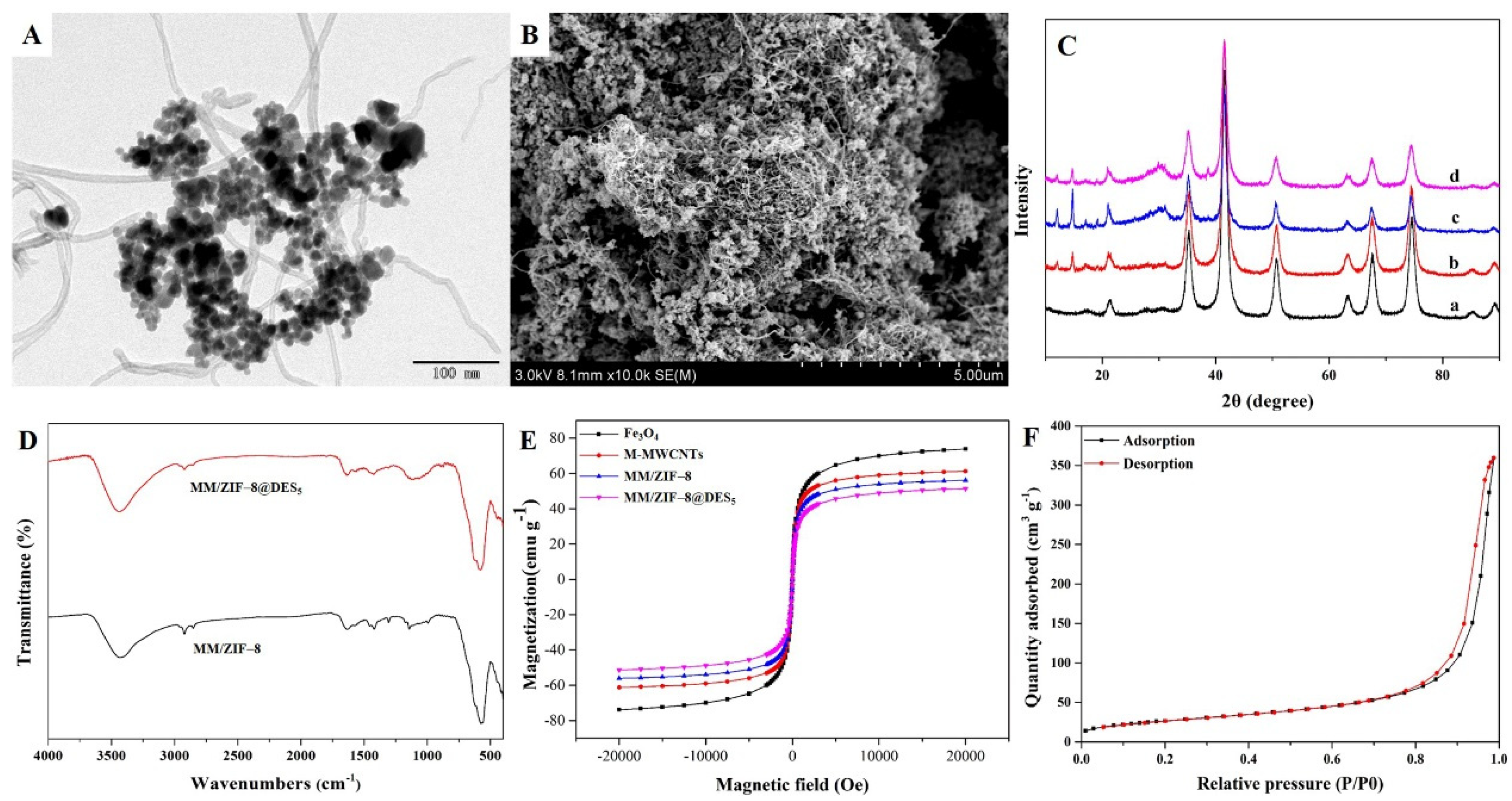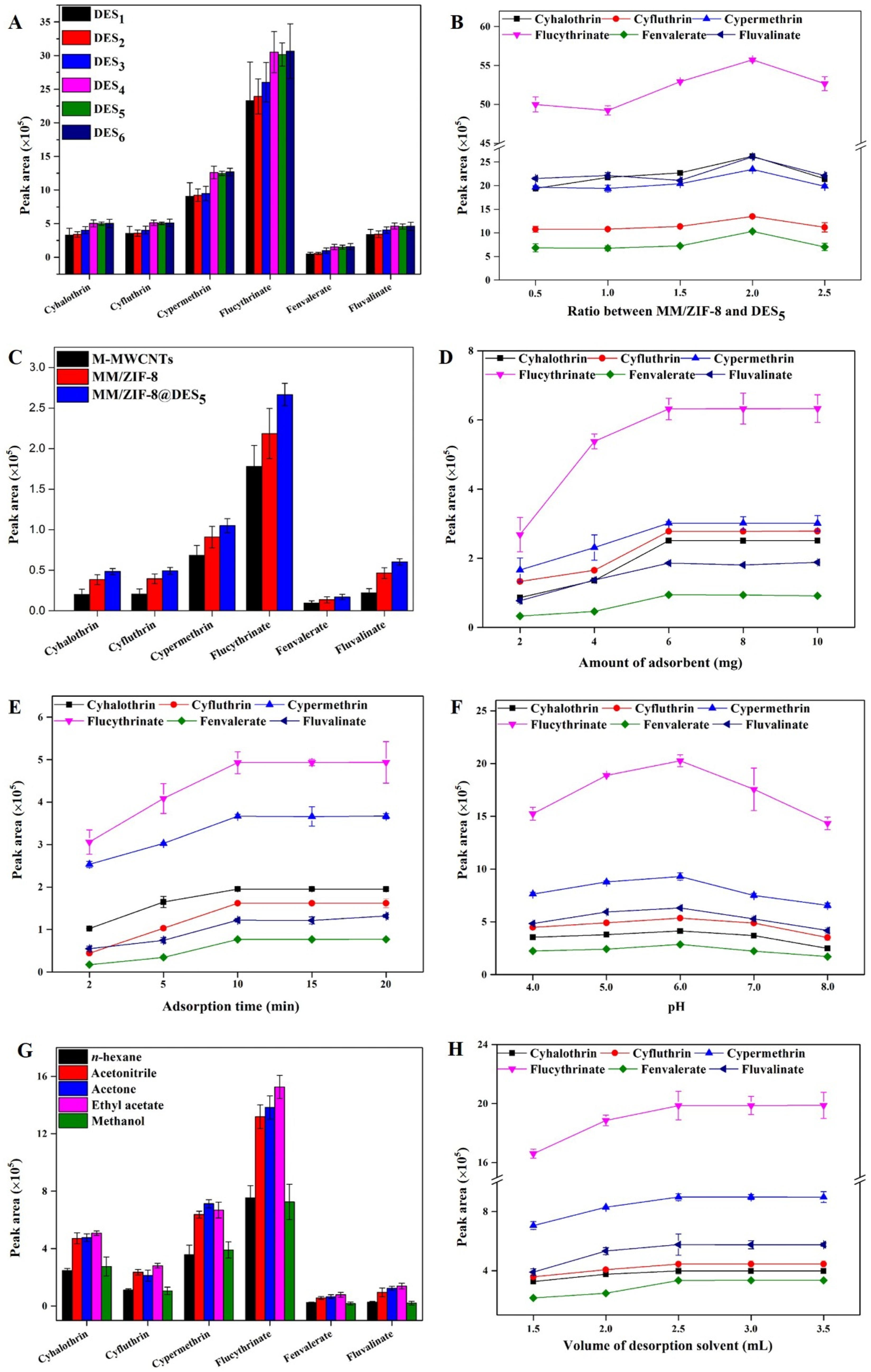Magnetic Composite Based on Carbon Nanotubes and Deep Eutectic Solvents: Preparation and Its Application for the Determination of Pyrethroids in Tea Drinks
Abstract
:1. Introduction
2. Materials and Methods
2.1. Preparation of Magnetic Materials
2.1.1. Preparation of MM/ZIF−8
2.1.2. Preparation of MM/ZIF−8@DES
2.2. The MSPE Procedure
3. Results and Discussions
3.1. Characterization of Magnetic Materials
3.2. The Optimization of the MSPE Parameters
3.2.1. Selection of Type and Quantity of DES5
3.2.2. Effect of Type and Dosage of Adsorbent
3.2.3. Effect of Extraction Time
3.2.4. Effect of pH of Sample Solution
3.2.5. Selection of the Type and Volume of Desorption Solvent
3.3. Method Validation
3.4. Comparison of the Proposed MSPE with Other Published Methods
3.5. Real Sample Analysis
4. Conclusions
Author Contributions
Funding
Data Availability Statement
Conflicts of Interest
References
- Jiang, H.-L.; Li, N.; Cui, L.; Wang, X.; Zhao, R.-S. Recent application of magnetic solid phase extraction for food safety analysis. TrAC Trend. Anal. Chem. 2019, 120, 115632. [Google Scholar] [CrossRef]
- Keçili, R.; Ghorbani-Bidkorbeh, F.; Dolak, İ.; Canpolat, G.; Karabörk, M.; Hussain, C.M. Functionalized magnetic nanoparticles as powerful sorbents and stationary phases for the extraction and chromatographic applications. TrAC Trends Anal. Chem. 2021, 143, 116380. [Google Scholar] [CrossRef]
- Huang, Y.; Li, Y.; Luo, Q.; Huang, X. One-step preparation of functional groups-rich graphene oxide and carbon nanotubes nanocomposite for efficient magnetic solid phase extraction of glucocorticoids in environmental waters. Chem. Eng. J. 2021, 406, 126785. [Google Scholar] [CrossRef]
- Liu, Z.; Wang, J.; Wang, Z.; Xu, H.; Di, S.; Zhao, H.; Qi, P.; Wang, X. Development of magnetic solid phase extraction using magnetic amphiphilic polymer for sensitive analysis of multi-pesticides residue in honey. J. Chromatogr. A 2022, 1664, 462789. [Google Scholar] [CrossRef]
- Meseguer-Lloret, S.; Torres-Cartas, S.; Gómez-Benito, C.; Herrero-Martínez, J.M. Magnetic molecularly imprinted polymer for the simultaneous selective extraction of phenoxy acid herbicides from environmental water samples. Talanta 2022, 239, 123082. [Google Scholar] [CrossRef]
- Li, T.; Lu, M.; Gao, Y.; Huang, X.; Liu, G.; Xu, D. Double layer MOFs M-ZIF-8@ZIF-67: The adsorption capacity and removal mechanism of fipronil and its metabolites from environmental water and cucumber samples. J. Adv. Res. 2020, 24, 159–166. [Google Scholar] [CrossRef]
- Rathinavel, S.; Priyadharshini, K.; Panda, D. A review on carbon nanotube: An overview of synthesis, properties, functionalization, characterization, and the application. Mat. Sci. Eng. B 2021, 268, 115095. [Google Scholar] [CrossRef]
- Ehzari, H.; Safari, M.; Samimi, M. Signal amplification of novel sandwich-type genosensor via catalytic redox-recycling on platform MWCNTs/Fe3O4@TMU-21 for BRCA1 gene detection. Talanta 2021, 234, 122698. [Google Scholar] [CrossRef]
- Wang, Y.; Zhang, N.; Tan, D.; Qi, Z.; Wu, C. Facile synthesis of enzyme-embedded metal–organic frameworks for size-selective biocatalysis in organic solvent. Front. Bioeng. Biotechnol. 2020, 8, 714. [Google Scholar] [CrossRef]
- Miensah, E.D.; Khan, M.M.; Chen, J.Y.; Zhang, X.M.; Wang, P.; Zhang, Z.X.; Jiao, Y.; Liu, Y.; Yang, Y. Zeolitic imidazolate frameworks and their derived materials for sequestration of radionuclides in the environment: A review. Crit. Rev. Env. Sci. Tec. 2020, 50, 1874–1934. [Google Scholar] [CrossRef]
- Pan, Y.; Liu, Y.; Zeng, G.; Zhao, L.; Lai, Z. Rapid synthesis of zeolitic imidazolate framework-8 (ZIF-8) nanocrystals in an aqueous system. Chem. Commun. 2011, 47, 2071–2073. [Google Scholar] [CrossRef] [PubMed]
- Liu, H.; Jiang, L.; Lu, M.; Liu, G.; Li, T.; Xu, X.; Li, L.; Lin, H.; Lv, J.; Huang, X.; et al. Magnetic solid-phase extraction of pyrethroid pesticides from environmental water samples using deep eutectic solvent-type surfactant modified magnetic zeolitic imidazolate framework-8. Molecules 2019, 24, 4038. [Google Scholar] [CrossRef] [PubMed] [Green Version]
- Smith, E.L.; Abbott, A.P.; Ryder, K.S. Deep eutectic solvents (DESs) and their applications. Chem. Rev. 2014, 114, 11060–11082. [Google Scholar] [CrossRef] [Green Version]
- Herce-Sesa, B.; López-López, J.A.; Moreno, C. Advances in ionic liquids and deep eutectic solvents-based liquid phase microextraction of metals for sample preparation in environmental analytical chemistry. TrAC Trend. Anal. Chem. 2021, 143, 116398. [Google Scholar] [CrossRef]
- Santos, L.B.; Assis, R.S.; Barreto, J.A.; Bezerra, M.A.; Novaes, C.G.; Lemos, V.A. Deep eutectic solvents in liquid-phase microextraction: Contribution to green chemistry. TrAC Trend. Anal. Chem. 2022, 146, 116478. [Google Scholar] [CrossRef]
- Song, X.; Zhang, R.; Xie, T.; Wang, S.; Cao, J. Deep eutectic solvent micro-functionalized graphene assisted dispersive micro solid-phase extraction of pyrethroid insecticides in natural products. Front. Chem. 2019, 7, 594. [Google Scholar] [CrossRef] [PubMed]
- Chrustek, A.; Hołyńska-Iwan, I.; Dziembowska, I.; Bogusiewicz, J.; Wróblewski, M.; Cwynar, A.; Olszewska-Słonina, D. Current research on the safety of pyrethroids used as insecticides. Medicina 2018, 54, 61. [Google Scholar] [CrossRef] [Green Version]
- Bhatt, P.; Bhatt, K.; Huang, Y.; Lin, Z.; Chen, S. Esterase is a powerful tool for the biodegradation of pyrethroid insecticides. Chemosphere 2020, 244, 125507. [Google Scholar] [CrossRef]
- Zhu, Q.; Yang, Y.; Zhong, Y.; Lao, Z.; O’Neill, P.; Hong, D.; Zhang, K.; Zhao, S. Synthesis, insecticidal activity, resistance, photodegradation and toxicity of pyrethroids (A review). Chemosphere 2020, 254, 126779. [Google Scholar] [CrossRef]
- Bradberry, S.M.; Cage, S.A.; Proudfoot, A.T.; Vale, J.A. Poisoning due to pyrethroids. Toxico. Rev. 2005, 24, 93–106. [Google Scholar] [CrossRef]
- Aznar-Alemany, Ò.; Eljarrat, E. Introduction to Pyrethroid Insecticides: Chemical Structures, Properties, Mode of Action and Use. In Pyrethroid Insecticides; Eljarrat, E., Ed.; Springer: Berlin/Heidelberg, Germany, 2020; Volume 92, pp. 1–16. [Google Scholar] [CrossRef]
- Deng, W.; Yu, L.; Li, X.; Chen, J.; Wang, X.; Deng, Z.; Xiao, Y. Hexafluoroisopropanol-based hydrophobic deep eutectic solvents for dispersive liquid-liquid microextraction of pyrethroids in tea beverages and fruit juices. Food Chem. 2019, 274, 891–899. [Google Scholar] [CrossRef] [PubMed]
- Liu, G.; Li, L.; Huang, X.; Zheng, S.; Xu, X.; Liu, Z.; Zhang, Y.; Wang, J.; Lin, H.; Xu, D. Adsorption and removal of organophosphorus pesticides from environmental water and soil samples by using magnetic multi-walled carbon nanotubes @ organic framework ZIF-8. J. Mater. Sci. 2018, 53, 10772–10783. [Google Scholar] [CrossRef]
- Huang, X.; Liu, Y.; Liu, G.; Li, L.; Xu, X.; Zheng, S.; Xu, D.; Gao, H. Preparation of a magnetic multiwalled carbon nanotube@polydopamine/zeolitic imidazolate framework-8 composite for magnetic solid-phase extraction of triazole fungicides from environmental water samples. RSC Adv. 2018, 8, 25351–25360. [Google Scholar] [CrossRef] [PubMed] [Green Version]
- Huang, Y.; Wang, Y.; Pan, Q.; Wang, Y.; Ding, X.; Xu, K.; Li, N.; Wen, Q. Magnetic graphene oxide modified with choline chloride-based deep eutectic solvent for the solid-phase extraction of protein. Anal. Chim. Acta 2015, 877, 90–99. [Google Scholar] [CrossRef]
- Wang, J.; Liu, X.; Wei, Y. Magnetic solid-phase extraction based on magnetic zeolitic imazolate framework-8 coupled with high performance liquid chromatography for the determination of polymer additives in drinks and foods packed with plastic. Food Chem. 2018, 256, 358–366. [Google Scholar] [CrossRef]
- Zhang, H.; Wang, Y.; Xu, K.; Li, N.; Wen, Q.; Yang, Q.; Zhou, Y. Ternary and binary deep eutectic solvents as a novel extraction medium for protein partitioning. Anal. Methods 2016, 8, 8196–8207. [Google Scholar] [CrossRef]
- Yang, X.; Lin, X.; Mi, Y.; Gao, H.; Li, J.; Zhang, S.; Zhou, W.; Lu, R. Ionic liquid-type surfactant modified attapulgite as a novel and efficient dispersive solid phase material for fast determination of pyrethroids in tea drinks. J. Chromatogr. B 2018, 1089, 70–77. [Google Scholar] [CrossRef]
- Lu, N.; He, X.; Wang, T.; Liu, S.; Hou, X. Magnetic solid-phase extraction using MIL-101(Cr)-based composite combined with dispersive liquid-liquid microextraction based on solidification of a floating organic droplet for the determination of pyrethroids in environmental water and tea samples. Microchem. J. 2018, 137, 449–455. [Google Scholar] [CrossRef]
- Feng, T.; Ye, X.; Zhao, Y.; Zhao, Z.; Hou, S.; Liang, N.; Zhao, L. Magnetic silica aerogels with high efficiency for selective adsorption of pyrethroid insecticides in juices and tea beverages. New J. Chem. 2019, 43, 5159–5166. [Google Scholar] [CrossRef]
- Wang, Y.; Sun, Y.; Gao, Y.; Xu, B.; Wu, Q.; Zhang, H.; Song, D. Determination of five pyrethroids in tea drinks by dispersive solid phase extraction with polyaniline-coated magnetic particles. Talanta 2014, 119, 268–275. [Google Scholar] [CrossRef]
- Gao, L.; Chen, L. Preparation of magnetic carbon nanotubes for separation of pyrethroids from tea samples. Microchim. Acta 2013, 180, 423–430. [Google Scholar] [CrossRef]



| DES | HBA | HBD | Molar Ratio of HBA to HBD |
|---|---|---|---|
| DES1 | 1-methyl-3-octyl imidazolium chloride a | 1-undecanol b | 1:2 |
| DES2 | 1-methyl-3-octyl imidazolium chloride | 1-dodecanol c | 1:2 |
| DES3 | 1-methyl-3-octyl imidazolium chloride | 1-tridecanol d | 1:2 |
| DES4 | tetramethylammonium chloride e | 1-undecanol | 1:2 |
| DES5 | tetramethylammonium chloride | 1-dodecanol | 1:2 |
| DES6 | tetramethylammonium chloride | 1-tridecanol | 1:2 |
| GC Specification | MS Specification | ||
|---|---|---|---|
| Column | Rtx-5Ms capillary column (0.25 mm (id) × 30 m, 0.25 μm film thickness, Restek, Bellefonte, PA, USA) | Interface temperature | 300 °C |
| Column oven temp | 40 °C (4 min), 40–125 °C at 25 °C min−1, 125–300 °C at 10 °C min−1, and finally held for 6 min. The total run time was 21 min | Ion source temperature | 200 °C |
| Carrier gas and column flow | Helium flow rate = 1.0 mL min−1 | Measurement mode | MRM |
| Injection | 1.0 μL, splitless mode | — | — |
| Analytes | tR (min) | MRM1 (m/z) | CE1 (eV) | MRM2 (m/z) | CE2 (eV) |
|---|---|---|---|---|---|
| Cyhalothrin-1 | 18.785 | 197.0 > 161.0 | 8 | 197.0 > 141.0 | 12 |
| Cyhalothrin-2 | 18.962 | 197.0 > 161.0 | 8 | 197.0 > 141.0 | 12 |
| Cyfluthrin-1 | 20.304 | 226.1 > 206.1 | 14 | 226.1 > 199.1 | 6 |
| Cyfluthrin-2 | 20.398 | 226.1 > 206.1 | 14 | 226.1 > 199.1 | 6 |
| Cyfluthrin-3 | 20.461 | 226.1 > 206.1 | 14 | 226.1 > 199.1 | 6 |
| Cyfluthrin-4 | 20.501 | 226.1 > 206.1 | 14 | 226.1 > 199.1 | 6 |
| Cypermethrin-1 | 20.630 | 163.1 > 127.1 | 6 | 163.1 > 91.0 | 14 |
| Cypermethrin-2 | 20.733 | 163.1 > 127.1 | 6 | 163.1 > 91.0 | 14 |
| Cypermethrin-3 | 20.793 | 163.1 > 127.1 | 6 | 163.1 > 91.0 | 14 |
| Cypermethrin-4 | 20.831 | 163.1 > 127.1 | 6 | 163.1 > 91.0 | 14 |
| Flucythrinate-1 | 20.794 | 199.1 > 157.1 | 10 | 199.1 > 107.1 | 22 |
| Flucythrinate-2 | 20.985 | 199.1 > 157.1 | 10 | 199.1 > 107.1 | 22 |
| Fenvalerate-1 | 21.430 | 419.1 > 225.1 | 6 | 419.1 > 167.1 | 12 |
| Fenvalerate-2 | 21.640 | 419.1 > 225.1 | 6 | 419.1 > 167.1 | 12 |
| Fluvalinate-1 | 21.540 | 250.1 > 55.0 | 20 | 250.1 > 200.0 | 20 |
| Fluvalinate-2 | 21.600 | 250.1 > 55.0 | 20 | 250.1 > 200.0 | 20 |
| Analytes | Calibration | Linear Range (μg L−1) | R2 | Intraday RSD (%) | Interday RSD (%) | LOD (μg L−1) |
|---|---|---|---|---|---|---|
| Cyhalothrin | y = 3703.2x −46478 | 0.5–400 | 0.9905 | 4.00 | 7.57 | 0.08 |
| Cyfluthrin | y = 3791.2x −47015 | 0.5–400 | 0.9907 | 4.84 | 7.56 | 0.33 |
| Cypermethrin | y = 8168.8x −92816 | 0.5–400 | 0.9925 | 2.99 | 5.77 | 0.22 |
| Flucythrinate | y = 19644.0x −251300 | 0.5–400 | 0.9910 | 3.50 | 5.83 | 0.13 |
| Fenvalerate | y = 3037.9x −38641 | 0.5–400 | 0.9912 | 4.83 | 7.66 | 0.24 |
| Fluvalinate | y = 5608.7x −59333 | 0.5–400 | 0.9922 | 5.58 | 8.58 | 0.10 |
| Method | Sorbent | Sample Amount (mL) | Sorbent Amount (mg) | Extraction Time (min) | Volume of Eluent (mL) | Linear Range (μg L−1) | LOD (µg L−1) | Ref. |
|---|---|---|---|---|---|---|---|---|
| MSPE-DLLMESFO- GC-ECD | Fe3O4/MIL-101(Cr) | 50 | 10 | 10 | methanol, 0.4 | 0.05–10 | 0.008–0.015 | [29] |
| MPSE-GC | Magnetic silica aerogels | 2.5 | 30 | 10 | ethyl acetate | 0.04–8 | 0.008–0.024 | [30] |
| dSPE-UFLC-UV | Fe3O4/C/PANI microbowls | 150 | 8 | 12 | methanol, 3 | 0.1–20 | 0.025–0.032 | [31] |
| MSPE-HPLC-UV | Fe3O4-MCNTs | 10 | 40 | 15 | 5% acetic acid acetonitrile, 3 | 0.05–25 μg g−1 | 0.010–0.018 μg g−1 | [32] |
| MSPE-GC-MS/MS | MM/ZIF−8@DES | 5 | 6 | 10 | ethyl acetate, 3 | 0.5–400 | 0.08–0.33 | This work |
| Matrix | Analyte | Spiked Levels (μg L−1, n = 3) | ||||
|---|---|---|---|---|---|---|
| 0 | 10 | 100 | ||||
| Found | Recovery (%) | RSD (%) | Recovery (%) | RSD (%) | ||
| Red tea | Cyhalothrin | <LOD | 72.5 | 7.1 | 85.4 | 2.5 |
| Cyfluthrin | <LOD | 76.3 | 3.2 | 86.1 | 2.8 | |
| Cypermethrin | <LOD | 77.5 | 6.6 | 82.5 | 5.3 | |
| Flucythrinate | <LOD | 70.4 | 6.2 | 87.7 | 2.1 | |
| Fenvalerate | <LOD | 76.1 | 3.4 | 87.2 | 3.6 | |
| Fluvalinate | <LOD | 78.3 | 4.9 | 96.4 | 4.3 | |
| Green | Cyhalothrin | <LOD | 83.7 | 6.0 | 86.0 | 4.1 |
| tea | Cyfluthrin | <LOD | 75.2 | 5.1 | 84.0 | 1.9 |
| Cypermethrin | <LOD | 79.1 | 4.6 | 82.2 | 2.1 | |
| Flucythrinate | <LOD | 77.3 | 6.8 | 89.3 | 3.5 | |
| Fenvalerate | <LOD | 72.8 | 8.7 | 87.4 | 3.1 | |
| Fluvalinate | <LOD | 80.7 | 7.9 | 86.3 | 4.5 | |
| Oolong | Cyhalothrin | <LOD | 74.4 | 7.1 | 86.0 | 2.4 |
| tea | Cyfluthrin | <LOD | 75.2 | 6.8 | 83.8 | 2.9 |
| Cypermethrin | <LOD | 72.3 | 10.0 | 88.8 | 7.6 | |
| Flucythrinate | <LOD | 73.6 | 3.7 | 93.1 | 3.9 | |
| Fenvalerate | <LOD | 81.1 | 5.3 | 91.8 | 1.9 | |
| Fluvalinate | <LOD | 82.6 | 7.9 | 86.3 | 4.5 | |
Disclaimer/Publisher’s Note: The statements, opinions and data contained in all publications are solely those of the individual author(s) and contributor(s) and not of MDPI and/or the editor(s). MDPI and/or the editor(s) disclaim responsibility for any injury to people or property resulting from any ideas, methods, instructions or products referred to in the content. |
© 2022 by the authors. Licensee MDPI, Basel, Switzerland. This article is an open access article distributed under the terms and conditions of the Creative Commons Attribution (CC BY) license (https://creativecommons.org/licenses/by/4.0/).
Share and Cite
Huang, X.; Liu, H.; Xu, X.; Chen, G.; Li, L.; Zhang, Y.; Liu, G.; Xu, D. Magnetic Composite Based on Carbon Nanotubes and Deep Eutectic Solvents: Preparation and Its Application for the Determination of Pyrethroids in Tea Drinks. Foods 2023, 12, 8. https://doi.org/10.3390/foods12010008
Huang X, Liu H, Xu X, Chen G, Li L, Zhang Y, Liu G, Xu D. Magnetic Composite Based on Carbon Nanotubes and Deep Eutectic Solvents: Preparation and Its Application for the Determination of Pyrethroids in Tea Drinks. Foods. 2023; 12(1):8. https://doi.org/10.3390/foods12010008
Chicago/Turabian StyleHuang, Xiaodong, Huifang Liu, Xiaomin Xu, Ge Chen, Lingyun Li, Yanguo Zhang, Guangyang Liu, and Donghui Xu. 2023. "Magnetic Composite Based on Carbon Nanotubes and Deep Eutectic Solvents: Preparation and Its Application for the Determination of Pyrethroids in Tea Drinks" Foods 12, no. 1: 8. https://doi.org/10.3390/foods12010008






